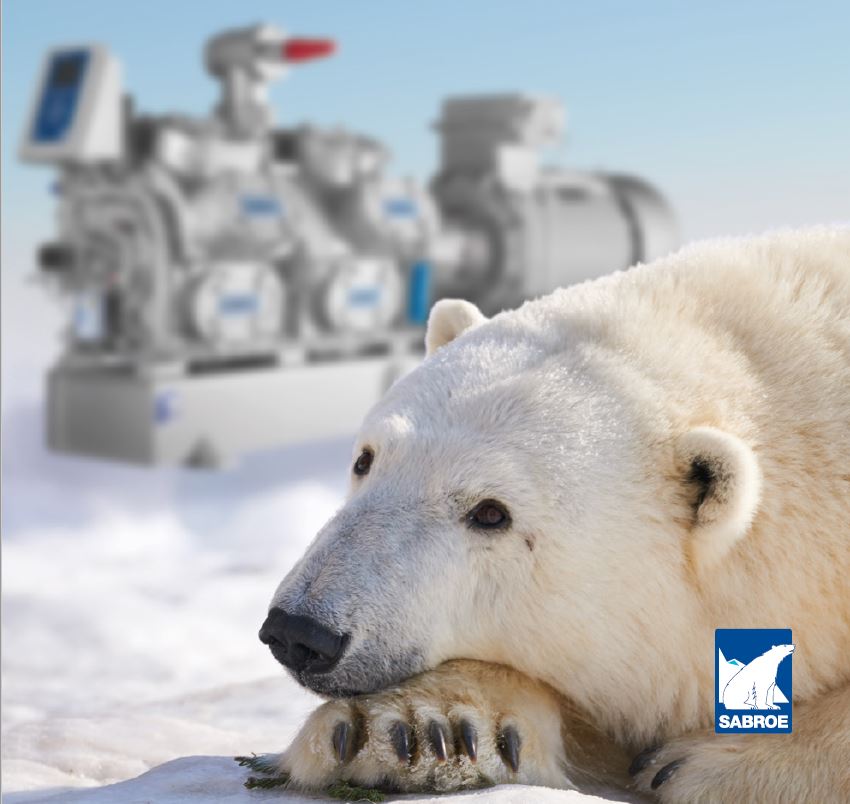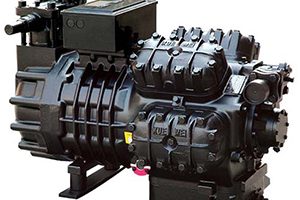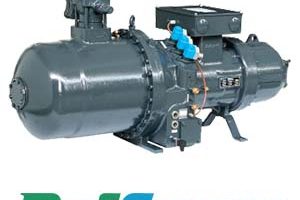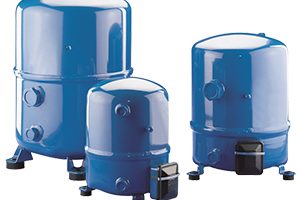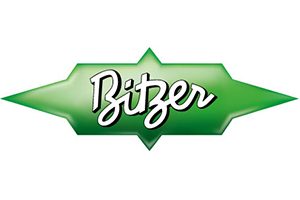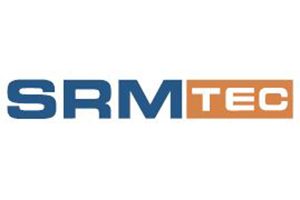Troubleshooting Sabroe Compressors – SMC & TSMC Series, MK4 Models
Permitted Applications for Sabroe Compressors
Using a Sabroe compressor outside its intended design may result in operator injuries and technical damage to the system. The compressor must only be used for the following purposes. In addition, before carrying out any service work, please read the Ammonia First Aid guidelines.
- As a refrigeration compressor, operated only within the permissible RPM limits specified in Sabroe Refrigeration references.
- SMC 100 and TSMC 100 compressors with code S and L are designed exclusively for use with refrigerants R717, R22, R134a, R407C, R404A, and R507.
- SMC 100 and TSMC 100 compressors with code E are designed exclusively for use with refrigerant R717 (Ammonia).
- SMC 100 and TSMC 100 compressors with codes S, L, and E must only operate at a maximum design discharge pressure of 25 bar (375 psi).
- The compressor must not be used for evacuating air or moisture from a refrigeration system.
- The compressor must not be used for pressure testing of a refrigeration system.
- The compressor must not be used as an air compressor.
Service and Maintenance of Sabroe Compressor Units
Daily Service of Sabroe Compressors
Daily service mainly consists of visual inspection. Once you are familiar with the normal sounds and vibrations of the unit, compare its daily performance with previous observations. Match the operating data and compressor performance diagrams for consistency.
- Inspect the compressor unit and ensure noise and vibration levels are within normal limits.
- Record all operating values in a logbook. Compare daily readings with the previous day to identify any trends. If necessary, create a report for closer analysis.
- Check the oil level in the oil separator (for screw compressors).
- Check the oil level in the compressor (for reciprocating compressors).
- Measure and record the oil pressure.
- Check the refrigerant charge.
- Inspect for leaks and eliminate them if found. Leaks may involve oil, refrigerant, cooling water, or brine circuits.
Warning
Daily operation and routine maintenance are normally performed by operators. Any additional servicing that requires system analysis and refrigeration engineering must only be carried out by authorized personnel.
Periodic Service of Sabroe Compressors
Lubrication of the motor and other routine maintenance tasks are typically scheduled based on operating hours, although they may be required earlier if necessary.
Overhaul and Major Service of Sabroe Compressors
For major overhauls and complete rebuilds of Sabroe compressors, the standard procedure is to contact the compressor supplier.
Use of the Sabroe Compressor Troubleshooting Table
In the table below, each possible fault is listed with a brief fault description in the “Fault Description” column, the code for the possible cause in the “Cause Code” column, and the fault code in the “Fault Code” column.
| Cause Code | Fault Description | Fault Code |
| 1-2-3-4-5-6-7-9-10-12-14 | Compressor does not start | 1 |
| 9-10-11-13-21-22-23-24-34-35-36-37-40-41-43-44-51-52-54-56-59 | Compressor cycles on and off at short intervals | 2 |
| 3-5-6-9-10-11-12-13-14-15-17-18-41-42-49-50-55-61 | Compressor starts but stops immediately | 3 |
| 8-21-22-24-41-46-52-53-56-60 | Compressor runs continuously | 4 |
| 16-17-18-19-26-48-49-50-51-52-53-54-56-57-58 | Abnormal noise from compressor | 5 |
| 13-15-17-18-20-21-22-23-24-32-34-35-36-37-40-41-44-45-46-49-50-51-52-23-56-60 | Insufficient compressor capacity | 6 |
| 16-18-26-37-38-39-44-56-61 | Compressor knocking during start-up | 7 |
| 21-23-26-37-39 | Compressor knocking during operation | 8 |
| 25-28-29-30-31-33 | High condenser pressure | 9 |
| 22-32-51-52-54-60 | Very low condenser pressure | 10 |
| 13-17-26-34-39-52-53-54-5-60 | High suction pressure | 11 |
| 11-13-20-21-22-23-32-35-36-37-40-41-42-44-45-56-59 | Very low suction pressure | 12 |
| 12-15-17-18-26-49-50-55 | Very low oil pressure | 13 |
| 11-21-22-23-28-29-30-31-33-34-35-36-37-40-41-46-52-54 | High discharge pipe temperature | 14 |
| 26-32-39 | Very low discharge pipe temperature | 15 |
| 33-34-35-36-37-40-50-52 | High oil temperature | 16 |
| 16-18-20-26-51-57-58 | Reduced oil level in crankcase | 17 |
| 16-26-39-61 | Severe foaming of oil in crankcase | 18 |
| 16-18-26-37-39 | Sweating or icing of crankcase | 19 |
| 13-15-16-17-18-49-55-56 | Intermittent capacity control | 20 |
Cause Codes Table
| Cause | Code | Cause | Code |
| Condenser cooling or airflow is excessive | 32 | Power is off – main switch is off | 1 |
| Water valve is closed | 33 | Fuses blown – connections or wiring are loose | 2 |
| External pressure equalizer on expansion valve is closed | 34 | Voltage is very low | 3 |
| Expansion valve blocked by ice, dirt, or wax | 35 | Control current is off | 4 |
| Expansion valve bulb charge is empty | 36 | Motor protection system is active | 5 |
| Expansion valve sensor not properly positioned | 37 | Check for open circuit | 6 |
| Expansion valve is leaking | 38 | Pump or fan is off | 7 |
| Expansion valve provides low superheat | 39 | Contactor is defective | 8 |
| Expansion valve produces high superheat | 40 | High-pressure control has tripped | 9 |
| Liquid or suction line filters are blocked | 41 | Low-pressure control has tripped | 10 |
| Liquid or suction solenoid valve is closed | 42 | Suction pressure control differential is too small | 11 |
| Solenoid valve is leaking | 43 | Oil pressure control has tripped | 12 |
| Evaporator frozen or blocked | 44 | Capacity control is incorrectly set | 13 |
| Cooling air is recirculated | 45 | Defrost timer has cut off current | 14 |
| Refrigeration load on system is excessive | 46 | Oil charge is low | 15 |
| Refrigerant is cold-stored in condenser | 47 | Compressor capacity very high at start-up | 16 |
| Coupling is not aligned or missing bolts | 48 | Oil pressure very low (pressure control setting) | 17 |
| Oil pump defective | 49 | Oil foaming in crankcase | 18 |
| Bearings worn or defective | 50 | Oil charge too high | 19 |
| Piston rings or cylinder defective | 51 | Poor oil return – oil in evaporators | 20 |
| Discharge valve leaking or defective | 52 | Refrigerant supply is restricted | 21 |
| Suction valve leaking or defective | 53 | Insufficient refrigerant charge | 22 |
| Compressor bypass open or safety valve leaking | 54 | Refrigerant vapor in liquid line | 23 |
| Compressor oil filter blocked | 55 | System leakage present | 24 |
| Capacity control defective | 56 | Refrigerant overcharge | 25 |
| Oil return solenoid valve blocked or defective | 57 | Liquid in suction line | 26 |
| Oil return filter blocked | 58 | Increased evaporator charge at low temperature | 27 |
| Compressor capacity too high | 59 | Condenser cooling or airflow insufficient | 28 |
| Compressor capacity too low | 60 | Condenser or air temperature too high | 29 |
| Oil heater element in crankcase defective | 61 | Non-condensable gases in condenser | 30 |
| Condenser needs cleaning | 31 |
This document has been compiled and extracted by Atlas Refrigeration Co. from Sabroe compressor technical references. As the most experienced and reputable company in supplying spare parts and overhauling Sabroe compressors, the company is ready to provide its services.
The S and L models are compatible with multiple refrigerants (R717, R22, R134a, R404A, and R507), while the E model is designed exclusively for ammonia (R717).
Bitzer compressors are produced in two types, semi-hermetic and open type, in which freon gases such as R-22, R-134a, R-404a, etc. can be used in the semi-hermetic models. In open-type models, in addition to Freon refrigerants, it is also possible to use R-717 ammonia refrigerant.
The most frequent issues are “failure to start” and “shutting down immediately after startup,” which are usually related to electrical problems, blown fuses, or protective sensors.
Because it is designed exclusively for refrigerants. Using it outside this scope can cause serious technical damage and pose safety risks for operators.
These are critical warnings. First, check oil levels, the operation of the oil pump, and the condition of the oil filter. If the problem persists, a certified technician should inspect the unit and replace worn components.
Related posts
Sabroe Compressor
Refrigeration Compressors from Leading American, European, and Asian Brands Refrigeration compressors are essential components of cold room systems, available in
Refcamp compressor Refcamp was founded in 1991 as a refrigeration compressor manufacturer in Italy. Refcamp’s production facilities are equipped with
Danfoss Compressors: A Legacy of Excellence The renowned Danfoss compressors, originally pioneered by Maneurop, have been at the forefront of
Introduction to Bitzer Compressor and Company History Germany’s Bitzer Company is a leading manufacturer specializing in refrigeration and air conditioning
What Is Ammonia Screw Compressor? An ammonia screw compressor is a type of compressor used in industrial refrigeration systems to
